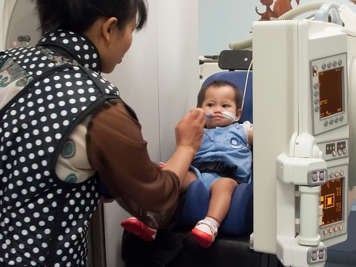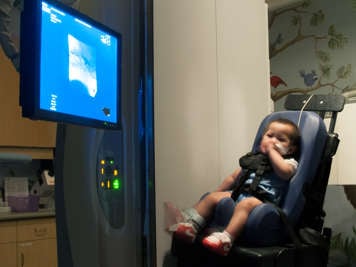A feeding study is done when swallowing problems are suspected during an occupational therapist's assessment of a child. A feeding study involves an image or video of the inside of your child's mouth and throat to help determine what your child can safely eat and drink. Using X-rays, a feeding study will examine what happens between the time food enters your child's mouth until after your child swallows. A child can have a feeding study at any age.

How long will your child's feeding study take?
Your child's feeding study will take about 20 to 30 minutes but you will be at the hospital for about one hour so that after the study you can talk to the occupational therapist about the results. The occupational therapist is specially trained to help your child drink and eat safely. Using the results of the feeding study, they will advise you on how and what to eat.
What should you tell your child about the feeding study?
The best thing you can do to prepare your child for a feeding study is to read this information carefully. It is important that you know what will happen during the feeding study so that you can explain it to your child in words he or she will understand. This will help your child feel more comfortable. Children who know what to expect are usually less worried.
What should you do to prepare your child for a feeding study?
Please make sure you follow these instructions:
- Do not give your child anything to eat or drink for three hours before the feeding study. This is to make sure your child is hungry enough to eat and drink during the study.
- Bring the feeding equipment that your child uses at home, such as a bottle, nipple, cup or spoon. Your therapist may ask you to bring certain foods for the test.
- Remove your child's jewelry or clothing with metal snaps. Metal can show up on the X-ray.
- Your child may be hungry after the feeding study. Bring food for your child to eat after the study. If your child uses tube-feeding equipment, please bring this with you.
Who will take part in your child's feeding study?
An occupational therapist, radiologist, and X-ray technologist will take part in your child's feeding study.
- An occupational therapist, radiologist, and X-ray technologist will take part in your child's feeding study. The occupational therapist will meet you and your child in the GI/GU waiting area before the feeding study. They will go with you into the room where your child will have the feeding study.
- A radiologist is a doctor who is specially trained to take and read X-rays. They will take your child's X-ray.
- An X-ray technologist sets up the equipment to take your child's X-ray. They will help the radiologist take the X-ray.
It is important that you or another family member or caregiver be with your child during the feeding study, if possible. If you want, you can feed your child during the feeding study. The occupational therapist can also help feed your child. Only one person should accompany your child into the feeding study.
If you are pregnant or think you may be pregnant, you should not take part in your child's feeding study.
What will happen during your child's feeding study?
Inside the feeding study room, you will see a chair where your child will sit. There will be a large camera and a TV screen beside this chair. Parents and caregivers will wear a lead apron during the feeding study to protect themselves from radiation. The lights in the room will be dim.

The radiologist will move the camera to the right spot to look at how your child swallows. For the best picture possible, your child will need to sit still and try not to lean forward or turn around. When your child is in the right position and the radiologist is ready, your child will start drinking or eating. The camera will make beeping noises as the X-rays are taken. It does not touch your child and the X-rays do not hurt.
What will your child drink and eat during the feeding study?
During the feeding study, your child may be asked to drink different liquids and eat different foods. He may be asked to drink a very thin liquid or eat solid food made up of sterile water, rice cereal, and barium. Barium is a white liquid that makes food show up on the X-ray. For older children, the liquid may taste like chocolate or fruit punch. As your child is eating, the occupational therapist and radiologist will be watching the screen to see how your child swallows.
What happens after the feeding study?
After the feeding study, the X-ray technologist or occupational therapist will take you to the waiting area. The occupational therapist will talk to you about the results of the feeding study and answer your questions. They will talk to you about how to feed your child. The occupational therapist will send the results of the feeding study to the doctor who sent your child for the test.
Are there any side effects?
The barium may make your child's stool look a little white the next few times that they go to the bathroom after the feeding study. This is normal.